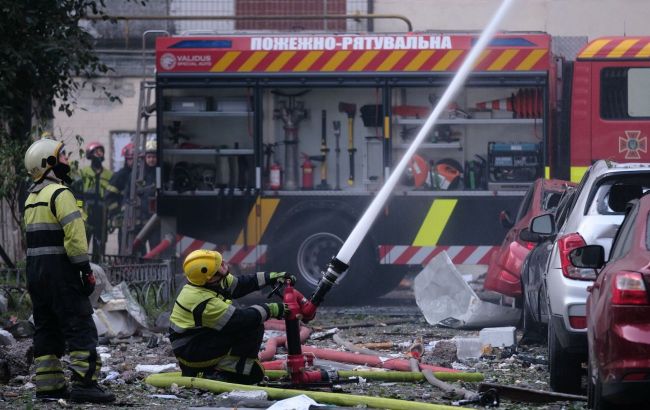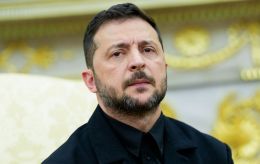Is Russia changing tactics? Strikes on Ukraine’s Cabinet of Ministers and Dnipro Bridge explained
 Photo: rescuers at the scene of one of the hits in Kyiv (Vitalii Nosach/RBC-Ukraine)
Photo: rescuers at the scene of one of the hits in Kyiv (Vitalii Nosach/RBC-Ukraine)
Russia set a new record for massive attacks, simultaneously launching over 800 drones at Ukraine. Some of them, as usual, struck residential buildings, while others hit, for the first time, the Cabinet of Ministers building in Kyiv and the Dnipro River bridge in Kremenchuk.
Whether the enemy managed to break through Ukraine's strongest zone of air defense and what the strikes on the Cabinet of Ministers and Kryukiv Bridge mean - read in the RBC-Ukraine material.
Key points
- New record - Russia launched 800+ drones and missiles;
- The Cabinet of Ministers building hit for the first time during the war;
- The attack shows that pleas have no effect on Putin;
- Strikes on Dnipro bridges could happen again
- Where Russia struck and what its goals were
On the night and morning of September 7, the enemy launched over 800 aerial attack assets, including 13 ballistic and cruise missiles. Shahed drones accounted for half.
Ukrainian air defense shot down (neutralized) 747 drones of various types and four missiles. Hits were recorded from nine missiles and 56 drones across dozens of locations. Strikes hit major cities - Kyiv, Dnipro, Kryvyi Rih, Odesa, Kremenchuk, and others. Currently, four people are confirmed dead and up to 50 are injured.
In particular, for the first time in the war, the Cabinet of Ministers building in Kyiv’s government district was damaged during an attack. Furthermore, hits on the Kryukiv Bridge over the Dnipro (Kremenchuk, Poltava region) paralyzed the crossing from the right to the left bank of central Ukraine for at least several days.
Russia pursues multiple objectives with its strikes. The first is outright terror against civilians, intimidation, and attempts to sow fear, according to Oleksandr Musiienko, Head of the Сenter for Military Law Research and a military expert.
"The second - the enemy determines which targets may become more important at a given period, such as energy, logistics, critical, and transport infrastructure. In previous attacks, railways suffered. Now bridges are added, and so on," Musiienko told RBC-Ukraine.
According to a Ukrainian military expert, Russia deliberately strikes large cities, knowing it will inevitably cause destruction and civilian casualties. In some cases, poorly planned drone routes result in residential buildings being hit. Furthermore, Ukrainian air defense reduces some attacks, but debris still causes damage on the ground.
"Each attack is different. Drones fly very low or very high, change altitudes, and constantly alter trajectories. Countering Shaheds is becoming more difficult," a military expert added.
Shahed strike on Cabinet of Ministers
Until September 7, 2025, the Cabinet building had never been hit. During the morning attack, the roof and upper floors caught fire.
 Photo: Fire at the Cabinet of Ministers building (Vitalii Nosach/RBC-Ukraine)
Photo: Fire at the Cabinet of Ministers building (Vitalii Nosach/RBC-Ukraine)
By the evening, the fire was extinguished. As Prime Minister of Ukraine, Yuliia Svyrydenko, reported, fortunately, there were no casualties. However, debris removal and significant reconstruction lie ahead.

Photo: Yuliia Svyrydenko shows the damaged Cabinet building (facebook.com/yulia.svyrydenko)
Oleksandr Musiienko does not consider the Cabinet the main target of this attack. While Russia regularly threatens strikes on "decision-making centers," this does not break Ukraine’s resistance.
"Maybe someone in the Kremlin is drawing up some scenarios in their sick head that such strikes will lead to something, will become some kind of signal. But I don't see any signals here," a Ukrainian military expert said.
Military expert and former spokesperson of the General Staff of the Armed Forces of Ukraine, Vladyslav Seleznov, said it is unclear whether Russia intentionally targeted the government quarter. He does not rule out Kyiv Mayor Vitali Klitschko's version that debris from a downed drone headed to another target could have caused the hit.
"However, the impact is a fact and a clear signal that pleas to Putin do not work. The only effective argument is the power of Ukrainian weapons - destroying Shahed production, launch sites, and eliminating operators. This increases our chances of survival," Seleznov told RBC-Ukraine.
Ukraine’s 'safest zone' is breached
The New York Times (NYT) noted that the Cabinet building is near the parliament and President Zelenskyy's office. The government quarter is effectively in the center of air defense rings and is considered the most protected zone in Ukraine.
The media outlet concluded that, most likely, the morning attack marked the first time Russians breached a well-protected area - a concern amid stalled diplomatic efforts to resolve the war.
However, Seleznov cautions against fully agreeing with the NYT assessment.
"Of course, Kyiv has a high concentration of air defense systems. But even dense air defense cannot be 100% effective," a military expert explains.
Even Israel's highly regarded air defense sometimes struggles against relatively unsophisticated missiles.
"There's no perfect weapon. This time, Russia succeeded due to massive drone use. The problem is that they've accumulated a lot. We should stay alert because the enemy will continue missile-drone terror periodically,” Seleznov added.
What attack on Kryukiv Bridge means
In Kremenchuk, from 01:00 to 04:00 a.m. local time on September 7, about 40 explosions sounded. Videos online show at least two Shahed UAVs striking the Kryukiv Bridge over the Dnipro.
 Photo: Shahed UAV hitting Kryukiv Bridge (t.me/vitalii_maletskyi/1085)
Photo: Shahed UAV hitting Kryukiv Bridge (t.me/vitalii_maletskyi/1085)
This important bridge connects both banks of Kremenchuk and the right- and left-bank parts of central Ukraine. In addition to cars, it supports rail traffic. The nearest alternative railway routes are an hour away via the dam in Svitlovodsk or dams in Cherkasy and Kamianske (about 150 km upstream and downstream).
The night strike partially paralyzed the Kryukiv Bridge for several days. Ukrainian railway company Ukrzaliznytsia rerouted long-distance trains to the Cherkasy dam. For example, the Chop-Kremenchuk train now stops at Kryukiv-na-Dnipri station (right bank), with buses shuttling passengers to the city center.
Car lanes were also damaged. Local authorities launched free buses from the left to the right bank via Svitlovodsk and later reopened the bridge to cars.
"About a year ago, it became clear there would be a phase of missile-drone terror against infrastructure, primarily railways, because they carry most military cargo. There aren't many Dnipro bridges. Therefore, damage requiring repair time creates serious logistics issues from right to left bank," explains Seleznov.
The enemy understands that logistics sustain Ukraine's army. Disruption would have catastrophic battlefield consequences. Such strikes on bridges may repeat.
"Drone strikes are cheaper than missiles and can be launched in greater numbers, ensuring some hit the target. This is more effective than using expensive missiles, which are likely intercepted by our air defense," the military expert said.
Musiienko emphasizes that bridges are always high-priority targets, so security and air defense are reinforced around crossings.
"Of course, Russia seeks to block logistics, such threats always exist. Especially when the enemy accumulates hundreds of drones. If earlier they chose targets based on some specific goals, now bridges can be included in the 'expanded list'," the Ukrainian military expert noted.
Possibility of 1,000 Shahed UAVs in single attack
In the recent combined attack, the enemy used 800+ drones, setting a new record. The media has speculated for weeks when Russia could reach 1,000 drones in one strike.
According to Musiienko, Russia needs more time.
"To launch 800+ drones, the enemy paused for three weeks - no massive strikes during the Putin-Trump summit in Alaska, then White House talks. They were able to accumulate. To say when the enemy can launch 1,000 drones requires more time," a military expert told RBC-Ukraine.
Thousands of drones may be stockpiled, but it's unclear if the enemy can launch 1,000 in a short period.
"Undoubtedly, Russia aims for this. It depends on the accumulation before the next attack. If 800+ drones take less than three weeks, that's concerning. But talking about 1,000+ is premature, though the risk exists,” Musiienko added.
Sources: official data about the consequences of the Russian record attack on Ukraine, statements by Prime Minister Yuliia Svyrydenko, The New York Times publications, and exclusive comments from military experts Oleksandr Musiienko and Vladyslav Seleznov.
Previously, Russia claimed the September 7 attack targeted drone production and storage bases, as well as Ukrainian military airfields.
Ukraine's partners condemned the barbaric strike and called Putin a killer of Ukrainian women and children.

